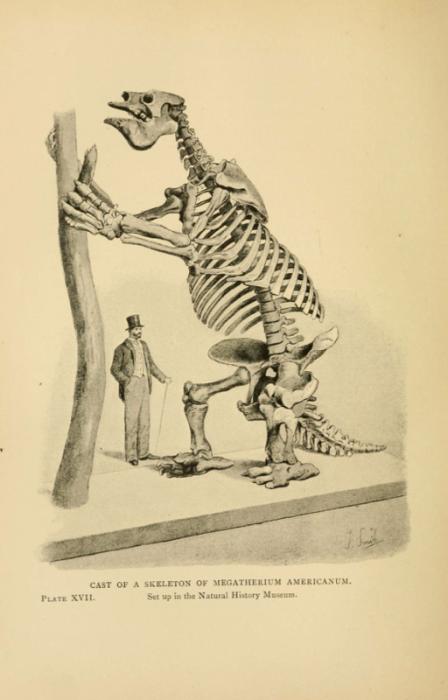News
18.04.2017
The Giant Sloth was a Vegetarian
The diet of the fossil Megatherium has been decoded
Together with an international team, Senckenberg scientists examined the diet of the extinct Giant
Sloth Megatherium. Based on analyses of the collagen in the fossil bones, the researchers concluded in their study, which was recently published in the scientific journal “ScienceDirect,” that Megatherium subsisted on an exclusively vegetarian diet. Until recently, there had been much speculation about the food habits of these elephantsized,
ground-dwelling animals.
Sloths may well rank among the world’s most peculiar animals: With their backs pointing downward, they hang in trees and move in slow motion from branch to branch with the aid of their sickleshaped claws. “Sloths already occurred 10,000 years ago, for example the species Megatherium,” explains Professor Dr. Hervé Bocherens of the Senckenberg Center for Human Evolution and Palaeoenvironment at the University of Tübingen.
The extinct relatives of the sloths could reach the size of an elephant and were much too heavy to spend a significant amount of time in the trees. Instead, they lived on the ground, where they excavated large burrows. For many years, their dietary habits were an enigma; the long claws on their hands and feet, in particular, gave rise to various speculations. Did the sloths use their claws to dig up subterranean insect colonies? Did the long claws serve as hunting tools, and were the giant animals carnivores? Or did the fossil representatives live on a strictly vegetarian diet, like the recent sloths? “These questions were at the center of our new study,” adds Bocherens.
Normally it is possible to deduce the feeding habits of fossil animals on the basis of the shape and wear of their teeth – however, the teeth of the Giant Sloth are not comparable to those of modern animals. “We therefore had to use a different method, so we measured the composition of carbon isotopes – the ratio of protein and mineral content – in the fossilized sloth bones,” explains Bocherens, and he continues, “Our measurements show that Megatherium lived on an exclusively vegetarian diet.”
In carnivores, the proportion of proteins is significantly higher than in herbivores, which primarily eat food high in carbohydrates. These differences can be documented in the isotopes. In order to reinforce their results, the scientists compared their data with more than 200 bones from modern mammals, whose diet is known, as well as with fossil specimens from both carnivores and herbivores. “Our results show that by using this method, it is possible to
reconstruct the feeding habits of animals even several thousand years after their death,” adds the biogeologist from Tübingen.
Knowledge of the sloths’ feeding habits is important in order to understand their role in past ecosystems. “Moreover, the results can help us understand the interactions between Megatherium and the first human inhabitants of America – their habitats overlapped for several thousand years, before the Giant Sloth became extinct,” offers Bocherens as a preview.
 | The sloths were too heavy to live in trees. © Drawing by Robert Bruce Horsfall, from “A history of land mammals in the western hemisphere.” |
Press images may be used at no cost for editorial reporting, provided that the original author’s name is
published, as well. The images may only be passed on to third parties in the context of current reporting.
This press release and the images are also available at <link http: www.senckenberg.de presse>www.senckenberg.de/presse
Contact
Prof. Dr. Hervé Bocherens
Senckenberg Center for Human Evolution and Palaeoenvironment (HEP)
Eberhard Karls Universität Tübingen
Phone 07071- 29-76988
<link>herve.bocherens[at]unituebingen.de
Judith Jördens
Press Office
Senckenberg Gesellschaft für Naturforschung
Phone 069- 7542 1434
<link>Pressestelle[at]senckenberg.de
Publication
Hervé Bocherens, Martin Cotte, Ricardo A. Bonini, Pablo Straccia, Daniel Scian, Leopoldo Soibelzon,
Francisco J. Prevosti, Isotopic insight on paleodiet of extinct Pleistocene megafaunal Xenarthrans from Argentina,
Gondwana Research, <link http: doi.org j.gr.2017.04.003>
doi.org/10.1016/j.gr.2017.04.003
.
To study and understand nature with its unlimited diversity of living creatures and to preserve and manage it in a sustainable fashion as the basis of life for future generations – that has been the goal of the Senckenberg Gesellschaft für Naturforschung (Senckenberg Nature Research Society) for almost 200 years. This integrative “geobiodiversity research” and the dissemination of research and science are among Senckenberg’s primary tasks. Three nature museums in Frankfurt, Görlitz and Dresden display the diversity of life and the earth’s development over millions of years. The Senckenberg Gesellschaft für Naturforschung is a member of the Leibniz Association. The Senckenberg Nature Museum in Frankfurt is supported by the City of Frankfurt am Main as well as numerous other partners. Additional information can be found at <link http: www.senckenberg.de>www.senckenberg.de
200 years of Senckenberg! 2017 marks Senckenberg’s anniversary year. For 200 years, the society, which was founded in 1817, has dedicated itself to nature research with curiosity, passion and involvement. Senckenberg will celebrate its 200-year success story with a colorful program consisting of numerous events, specially designed exhibitions and a grand museum party in the fall. Of course, the program also involves the presentation of current research and future projects. Additional information is available at: <link http: www.200jahresenckenberg.de>www.200jahresenckenberg.de.
The University of Tübingen is one of eleven German universities that received the recognition of excellence. Within the field of life sciences, it offers cuttingedge research in the areas of neurosciences, transnational immunology and cancer research, microbiology and infection research as well as molecular biology. Additional focal areas include geological and environmental research, archeology and anthropology, language and cognition as well as education and media. More than 28,400 students from all over the world are currently enrolled at the University of Tübingen. They can avail themselves of a wide spectrum of approximately 300 study courses – from Egyptology to Cellular Neurosciences.

